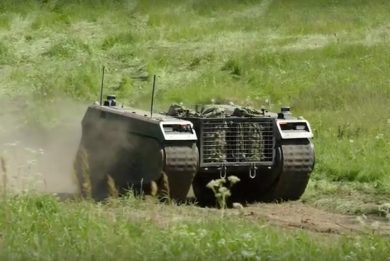ADVERTORIAL – Milrem Robotics is Leading the Charge in Autonomous Land Warfare
Unmanned ground vehicles (UGVs) are steadily emerging in modern theatres of war– as popular, off-the-shelf robotic combat or support solutions. This may mislead today’s civilian observers into assuming that UGVs are making their first appearance on the battlefield. In reality, the history of UGVs in land warfare traces back as far as the early 20th century, emerging in World War I with basic designs primarily intended for reconnaissance and target practice. It was during World War II, however, that the development and deployment of UGVs took significant strides, driven by the need for enhanced battlefield efficiency and reduced human casualties.
One notable example was the German Goliath tracked mine; a small, remote-controlled demolition vehicle designed to deliver explosive charges to enemy targets such as tanks, bunkers, and bridges. Controlled via a joystick and connected by a spool of wire, the Goliath could carry up to 100 kilograms of explosives. Despite its limited success, due to technical limitations and vulnerability to gunfire, the Goliath represented a crucial step in the evolution of UGV technology. The war also spurred further experimentation, paving the way for the post-war advancements that would lead to the sophisticated, multifunctional UGVs used in contemporary military operations.
Such rapid advancements in technology, particularly since the end of the Cold War, have seen the role and importance of UGVs in warfare change drastically. New capabilities have been developed and added to their arsenals, including sophisticated mine clearing, advanced reconnaissance, and comprehensive logistical support. Modern UGVs, such as those developed by Milrem Robotics – a leading robotics developer and manufacturer, based in Tallinn, Estonia, represent the pinnacle of this evolution. Featuring modular architectures that allow for rapid reconfiguration and multifunctional capabilities across various military applications, Milrem Robotics’ flagship product, the THeMIS UGV, epitomises the new role of the UGV in today’s military operations.
As a multi-role platform, the THeMIS has demonstrated its capabilities in diverse and challenging environments, including the anti-insurgency mission Operation Barkhane in Mali, as well as in the ongoing war in Ukraine. The Ukrainian armed forces, which have been supplied with 15 THeMIS UGVs since the outbreak of war, have employed Milrem Robotics’ UGVs in various critical tasks, including demining, route clearance, re-supply, and casualty evacuation, often in hazardous environments where human soldiers would be at significant risk. The THeMIS UGVs have proven particularly valuable during the muddy season in Ukraine (“bezdorizhzhia”), where their small size and mobility allow them to navigate areas inaccessible to conventional vehicles. Not only have the UGVs helped prevent the loss of equipment but, more importantly, they have protected soldiers’ lives by allowing operations to be conducted remotely.
Providing a new range of critical advantages to frontline troops, Milrem Robotics’ THeMIS UGV is, by and large, the most advanced and cost-effective autonomous ground vehicle available today. Its affordability does not, however, compromise quality. Instead, its cost-effectiveness has even broadened its accessibility to a wider range of military forces.
The THeMIS also stands out for its exceptional modularity and is the preferred platform for third-party payload integrations, including technology by KONGSBERG, FN Herstal, Thales, Leonardo and EOS. With its open architecture and system flexibility, it offers clients a unique opportunity to innovate while minimising costs, risks, and adoption time. Designed specifically for seamless integration into existing military systems, it ensures a rapid and straightforward deployment process. Coupled with its minimal training requirements, operators can quickly achieve operational readiness, making the THeMIS a prime choice for forces needing immediate capability. Milrem Robotics’ expertise in Capability Development & Experimentation (CD&E) and CONOPS development also further simplifies integration into existing force structures, speeding up the adoption of robotic combat vehicles into existing fleets.
Milrem Robotics has dramatically expanded its development and production capabilities since its formation, having established facilities across Estonia, Poland, the Netherlands, Sweden, the UAE, and the US, while forging groundbreaking partnerships, including incorporating Starlink satellite communications (SATCOM) to its UGVs. Milrem Robotics is also a key contributor to European Union defence initiatives, having led the integrated Modular Unmanned Ground System (iMUGS) consortium, developing the architecture for the European standard unmanned ground system (UGS), as well as other related projects such as Combat Unmanned Ground Systems (CUGS), iMEDCAP (development of intelligent military capabilities to evacuate contagious, injured and contaminated staff) and DeterMine (Detecting and recognising mines and IEDs hidden in the environment). Milrem Robotics continues to drive new contracts with partner countries – Japan and Sweden being the latest nations to have placed orders for the THeMIS UGV.
Visit Milrem Robotics website, HERE.
Ground warfare strategies are shifting and UGVs are emerging as a central and enduring component in both direct combat and support roles. Leading this evolution is Milrem Robotics, a company that is actively shaping the future of the UGV by delivering groundbreaking autonomous technology that is both advanced and accessible. Positioned to continue its rise as the world’s foremost robotics leader, Milrem Robotics is etching its name into the history books of autonomous land warfare.




